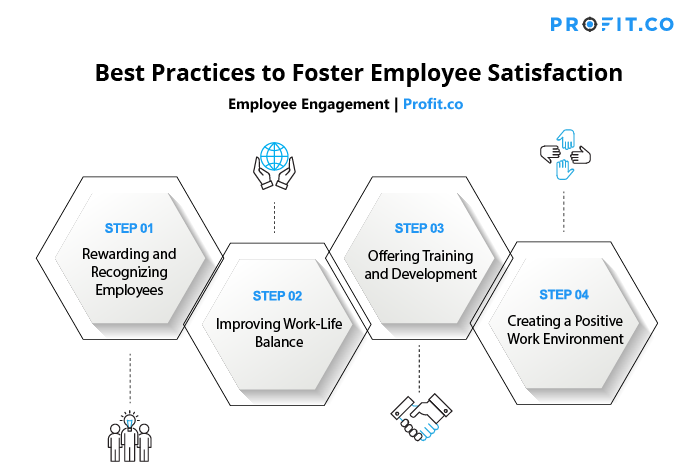Employee satisfaction is one of the most important factors to monitor in any organization, but it’s also one that’s most often overlooked when it comes to a business meeting its goals.
Most top-ranking organizations understand that for a business to meet its goals, its employees need to feel satisfied, engaged, and most of all, happy when they’re at work. However, balancing employee satisfaction with a business’s goals can be a difficult task, particularly for newer businesses that aren’t sure how to measure job satisfaction.
With that in mind, here are the best practices for improving job satisfaction and why it’s vital to your business.
What is Employee Satisfaction?
Employee satisfaction, also referred to as job satisfaction, is the measure of how happy and content your employees are with their jobs. It’s a key part of overall employee engagement in the workplace, as happy employees are likely to be more engaged and productive.
However, it’s important to understand that satisfaction isn’t the same thing as engagement. Just because an employee has high job satisfaction, it doesn’t guarantee that they’ll be more engaged – and vice versa.
Because of this, job satisfaction needs to be seen as part of your employee engagement strategy, not a replacement for it.
Why is Employee Satisfaction Important?
Employee satisfaction, and a higher job satisfaction index, is a vital part of any employee engagement strategy. By keeping your employees happy, you can:
- Reduce turnover. Not only will this reduce the cost of having to replace employees and train new ones, but it will also help to prevent lost morale from losing valuable team members.
- Increase loyalty. Happy employees will often be your biggest advocates, both with other people who are interested in working for your company and with your customers.
- Better customer service. Your customers know the difference between happy employees and those unsatisfied at work because happier employees will often go the extra mile to keep customers satisfied.
- Higher productivity. Employees who feel satisfied with their work tend to be more productive because they have a greater emotional connection with their work.
Everyone talks about building a relationship with your customer. I think you build one with your employees first.
Best Practices to Foster Employee Satisfaction
What most organizations get wrong about improving employee satisfaction is that it’s not always about workplace benefits. While job satisfaction will lean on aspects like salary, working hours, and other benefits like health insurance, improving happiness at work can’t be done solely through the provision of free lunches and vacation days.

Let’s take a detailed look at the best strategies to improve employee satisfaction.
Rewarding and Recognizing Employees
Employees thrive in the workplace when their hard work is recognized by their managers. People like to hear that their work has made an impact because, to some degree, everyone has an emotional connection with the work they produce.
However, more often than not, organizations don’t understand that employees want to hear they’re doing a good job. Not only does this lead to reduced productivity, but it’s also a leading cause of employee turnover.
To improve job satisfaction, organizations need to implement some form of recognition and reward system that all employees can use to receive feedback on their performance. Whether that’s an informal system that encourages peers to praise each other or a software platform that allows leaders to send feedback in real-time is up to you and what works best for your employees.
Ensuring that employees are praised for their good work and feel that their contributions matter to their employer is a key driver of employee satisfaction. So, organizations need to have some kind of recognition and rewards system in place to improve job satisfaction.
Improving Work-Life Balance
With modern technology making it even easier for employees to work from home, balancing working and personal life can feel challenging when it’s even harder to disconnect from the office.
Of course, employees need a work-life balance to feel happy at work. Emergencies happen, and your employees need the flexibility to take care of themselves and their families. Even if your employees work in shifts, they need to know that if something happens, your organization offers them the flexibility to deal with it.
To improve work-life balance, here are a few ideas already being implemented in various companies.
The Right to Disconnect
In France, companies with more than 50 employees have to establish hours when their employees are not permitted to send or answer work-related emails or calls. This policy guarantees time away from work, so employees can fully rest and enjoy their personal life between shifts.
Paid Vacation, Sick, Maternity, and Paternity Leave
Employees who need time away from work, whether that’s for health reasons, because they have a new baby, or because they need time to rest, often don’t take it because they can’t afford to. Policies that guarantee pay when someone needs to take time away from work ensure that they can fully rest or take care of their responsibilities before they return to work.
Flexible Work Schedules
Allowing your employees to move their hours around, or have a say in when they have scheduled shifts, is a significant driver of satisfaction as it gives employees more control. Other flexible policies like allowing employees to work from home when they need to, or even regularly, can also boost job satisfaction by reducing the stress of commuting.
Offer Training and Development
As an employer, you need to help your employees to succeed in their job roles. Not only will this boost their productivity, but also make them feel like they are making more of a difference in the workplace.
Most workplaces will offer training related to an employee’s job role, but you could also offer wider training or even a training budget for employees to spend on whatever they want to learn. This is a great way to help drive employee loyalty and encourage them to learn new skills they can use in their work.
Create a Positive Work Environment
Every employee has a story about a toxic coworker or boss, and more often than not, these people are the reason why employees are unhappy at work. It’s your responsibility to create a positive work environment that removes any negative influences on their work that reduces job satisfaction.
This means building a workplace culture that fosters trust, respect, and mutual appreciation of each other’s skills and contributions.
How to Measure Employee Satisfaction
There are two main ways to measure employee satisfaction in the workplace, but there are pros and cons to each method.
It’s worth understanding now that employee satisfaction isn’t easy to measure in isolation, which is why organizations need to take a scientific approach to measure the effectiveness of their employee satisfaction strategies. By working on employee satisfaction and measuring its effect on related metrics like customer satisfaction, employee turnover, and even the amount of workplace conflict, you can quickly find out whether your job satisfaction strategies are making the workplace better.
With both methods, the key areas you need to ask questions about are:
- Perception of management and other business leaders
- Interactions with coworkers and peers
- Whether they feel like they have the opportunity to grow
- What parts of the benefits package they use, and if they have any suggestions
- If they feel like they’re making a positive impact on the company
Employee Satisfaction Surveys
The first method is employee satisfaction surveys. This is the most popular method because this impersonal approach, where employees can speak anonymously about what they like and dislike about the company, means you can get honest feedback about the workplace.
The great thing about surveys is that, unlike meetings, you can generate quantitative data for job satisfaction indexes by using questions with numbered scales. The qualitative data you receive is also useful for learning more about how employees feel about things like management, their connection with you as an employer, and how they feel about their daily work.
Using a combination of these two approaches is the best way to create a survey, as you’ll get a wide range of data you can analyze.
Employee Meetings
Employee meetings can be a useful way of generating this kind of data, but depending on your organization and who’s running the meeting, employees might not feel comfortable giving honest feedback about whether they’re happy at work.
However, if employees are due to leave the company, exit interviews are a great way to find out how they felt about working for your organization, why they’re leaving, and if there was any way they would have considered staying.
Keeping Employee Satisfaction High: In Summary
High employee satisfaction is key to running a successful business, which is why you need to not only survey your employees about how they feel but also put strategies in place that make them feel happier and more empowered in the workplace. Implementing job satisfaction strategies needs to be part of your overall employee engagement plan, however, and it shouldn’t be seen as a quick fix for an unproductive workforce.
With the above practices, you’ll be one step closer to a happier, more empowered workforce.

